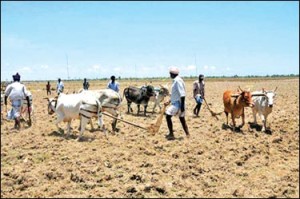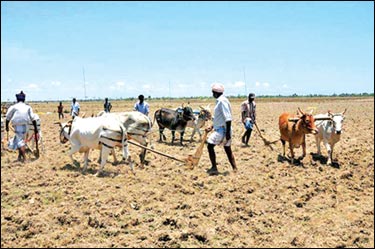 |
| Farmers in Vanni, Sri Lanka |
”More needs to be done if peace and reconciliation are to be achieved, including through the full implementation of the Thirteenth Amendment to the Constitution which would involve devolving land powers to the Provincial Councils and the establishment of the National Land Commission.”
Land Circular: 2013/01
Centre for Policy Alternatives/March 2013
In January 2013 the Government issued a new circular titled Accelerated Programme on Solving Post Conflict State Lands Issues in the Northern and Eastern Provinces- Land Circular 2013/01 (herein referred to as the Circular), which is the most recent effort by the Government to address land problems in the North and East. The Circular sets out a process to be implemented over two years in order to identify and address problems relating to State land in these two provinces. The Centre for Policy Alternatives (CPA) has prepared this short note to highlight key issues and concerns relating to this Circular and its implications if implemented.
Nearly four years after the end of the war, there is an urgent need to address the root causes of the war and the grievances of the affected communities. Land is a key issue requiring attention through a variety of measures which should pay due attention to individual‟s land rights and claims, and the history of the land. CPA has engaged in research and advocacy on land rights and related issues for over a decade, documenting developments and providing recommendations on land and related issues both in terms of the war and the tsunami.[i]
A key focus area of CPA‟s work has been on land issues in the North and East, as the war resulted in and exacerbated a variety of problems including access to land and displacement, occupation by state and non-state actors, competing claims, loss of documents and land records, which in turn has impacted individuals, families and communities in multiple ways. In the post-war context, CPA has critiqued and advocated for reform in the existing legal, policy and administrative structures so that problems on the ground and grievances of affected communities are addressed and a genuine effort is made by the Government to introduce and implement a programme that facilitates normalcy and reconciliation. This has also entailed advocacy on other initiatives in the post war period including the previous Land Circular (2011/4) and the need for an improved mechanism.[ii]
At the outset, CPA welcomes some of the constructive steps taken by the Government at the policy level in the post-war context to address land issues in the North and East including recognising the problems with the previous Land Circular (2011/4), withdrawing it and introducing the present Circular which is an improved version of the previous one. Problematic aspects in the previous Circular that were highlighted by CPA including the Land Commissioner General issuing a circular relating to both state and private land and military involvement in civilian administrative duties have been omitted in the new Circular. The Circular does respond to some of the complexities of the ground, including the difficulties in proving ownership and the need to recognise the competing claims of original claimants and those who have encroached or are occupying someone else‟s land and have developed these lands. The Circular however, needs to be supplemented by other processes, some of which are detailed below.
Although the Circular is an improvement from the previous one, there are provisions which lack clarity and are ambiguous. The Circular states at the outset that it is to apply only to state land and is to be implemented in 2013 and 2014, ensuring a narrow focus and application. What has been kept out of the Circular is the time period available for applications to be made, time to be taken to decide a matter and whether there will be an appeal process, in the event an individual feels unfair treatment with the process provided in the Circular. Furthermore, while the Circular explicitly states that it deals with issues related to state land, there is reference to private land under 2.2.1.2 which deals with „lost lands.‟ The Circular points to a number of scenarios through which land can be „lost’ such as lands being vacated or the occupants chased away during the conflict; being used for ‘development activities under government institutions and armed forces’ and ‘where other people have permanently settled on those lands’. The Circular instructs that alternate lands should be provided with consent of those who have „lost lands‟. There is also specific reference to private lands or lands distributed under state grants where the Circular provides for alternative land in accordance with „compensation assessment carried during the acquisition process of those lands‟.
According to the Land Acquisition Act No 9 of 1950 as amended, private land can be acquired for „public purposes‟ with the Act providing a process for such acquisition and the Minister identifying land that is to be acquired. The Circular seems to indicate that if private land or lands distributed under state grants are „lost‟ for „development activities’ or when „other people have permanently settled‟, then an acquisition process is to commence. Is the Circular implying that the reasons given above are to be now considered a „public purpose‟? Is the Land Commissioner General and/or other Government officials assuming powers provided to the Minister in accordance with the Land Acquisition Act who is to identify land for a „public purpose‟? If the language provided in the Circular is to be taken at face value, this particular issue goes beyond the powers provided to the Land Commissioner General whose mandate is solely on state land.
The Circular needs improvement in several areas, as highlighted in the following table. In particular, there needs to be greater clarity with regard to some terms that are used in the Circular such as „lost land’ and „development activities’. This is especially relevant given the concerns relating to state occupation, including by the military, the lack of information on whether land will continue to be occupied or released by the State, and the lack of acquisition and compensation processes so far. It is also paramount that the Government articulates its position on land in the post-war context, particularly in terms of the individual land rights of those who may be affected by such acquisitions. The present Circular implies that the Government‟s preference is towards „development activities’ and that individual land rights including those of landless people are to be treated as a secondary consideration.
While CPA notes that development is important in the transition towards a post- conflict context, there should also be consideration for people‟s rights and grievances. CPA reiterates that while the Land Circular is meant to assist in resolving land issues in the North and East in post-war Sri Lanka, it should not be used as a tool to interfere with the existing constitutional and legal framework and any amendments that are proposed should be done in adherence to the established process and done in a transparent and inclusive manner.
The Circular also provides broad powers to the Divisional Secretary (DS) to decide on state land issues. While it is important to use the knowledge of those who are closest to the people and aware of the history of the land, it is also important that clear guidance is provided to ensure consistency, uniformity and prevent the abuse of power. The use of land katcheris is a positive aspect but there is a need for an appeals process for those affected by problematic outcomes. It is also crucially important that the Government recognises the complex ethnic relations in the areas and resulting dynamics on land issues. This will not only provide for a more sustainable solution but will also provide public confidence in the process. As such there has to be some effort to strengthen community participation in the process, including through the involvement of community leaders when mediating complex disputes, which may be ethnicised and politicised.
The Circular is however, fundamental to addressing and resolving land issues in the North and East, thereby facilitating other processes such as the return and resettlement of displaced persons, the reconstruction of houses, restoration of livelihoods and the consolidation of peace and development. While the Circular sets out the framework for issues surrounding state land, there is no indication by the Government regarding plans pertaining to private land. While noting that the Land Commissioner General retains his purview of state land in the present Circular, there is a need to recognise that land issues in the North and East are much more complex than a simple distinction between what is “state” and “private”. Therefore, there needs to be a parallel process to address problems relating to private lands, especially in a context where there are numerous disputes and confusion over whether individual plots of land are state or privately owned.
A recurrent dual problem documented by CPA is the lack of transparency and the confusion related to current policies and the framework governing land on the one hand, and the ignorance among affected communities pertaining to their rights and how to secure these rights on the other. Therefore a vital step by the Government and all stakeholders is to raise awareness on land rights, the documents and the legal framework pertaining to land so that answers are provided to basic questions including what constitutes a legally valid document and as to how documentation to one‟s land can be obtained. There is also a need to raise awareness of this Circular and the process that it attempts to set in place.
While the Circular has a positive feature in that it does not restrict anyone in the country who has a problem pertaining to state land in the North and East from registering their problem, it is also extremely important that the Government addresses the needs of all those who maybe affected by the Circular, including those who are refugees and others who are overseas. This is particularly pertinent in a context where there is confusion as to what is state and private land -contestation of ownership and control of land being a key issue in the post-war context.
There is a need for a larger policy agenda to deal with land, including though not restricted to revisiting the existing legal and policy framework, amending arbitrary and archaic laws and making public the circulars and regulations that affect people‟s right to own, control and access their land. More needs to be done if peace and reconciliation are to be achieved, including through the full implementation of the Thirteenth Amendment to the Constitution which would involve devolving land powers to the Provincial Councils and the establishment of the National Land Commission.
For the full commentary including the table please visit here.
1 Centre for Policy Alternatives (CPA),“Informal Dispute Resolution in the North East and Puttlam”, (2003), available at http://www.cpalanka.org/wp-content/uploads/2007/8/Informal_Dispute_Resolution.pdf; CPA, “Land and Property Rights of Internally Displaced Persons”, (2003); CPA, „„Memorandum on Land Issues arising from the ethnic conflict and the tsunami disaster‟‟, (2005); Bhavani Fonseka & Mirak Raheem, “Trincomalee High Security Zone and Special Economic Zone”, CPA, (2009); Bhavani Fonseka & Mirak Raheem, “Land in the Eastern Province: Politics, Policy and Conflict”, CPA, (2010); Bhavani Fonseka & Mirak Raheem, “Land in the Northern Province Post-War Politics, Policy and Practices”, CPA, (2011).
[ii] Bhavani Fonseka & Mirak Raheem, “A Short Guide to „Regulating the activities regarding management of lands in the Northern and Eastern Provinces‟ Circular : Issues & Implications” , CPA, September 2011, available at http://www.scribd.com/fullscreen/65756001?access_key=key-2n9juixwucpeaun7qe09.
